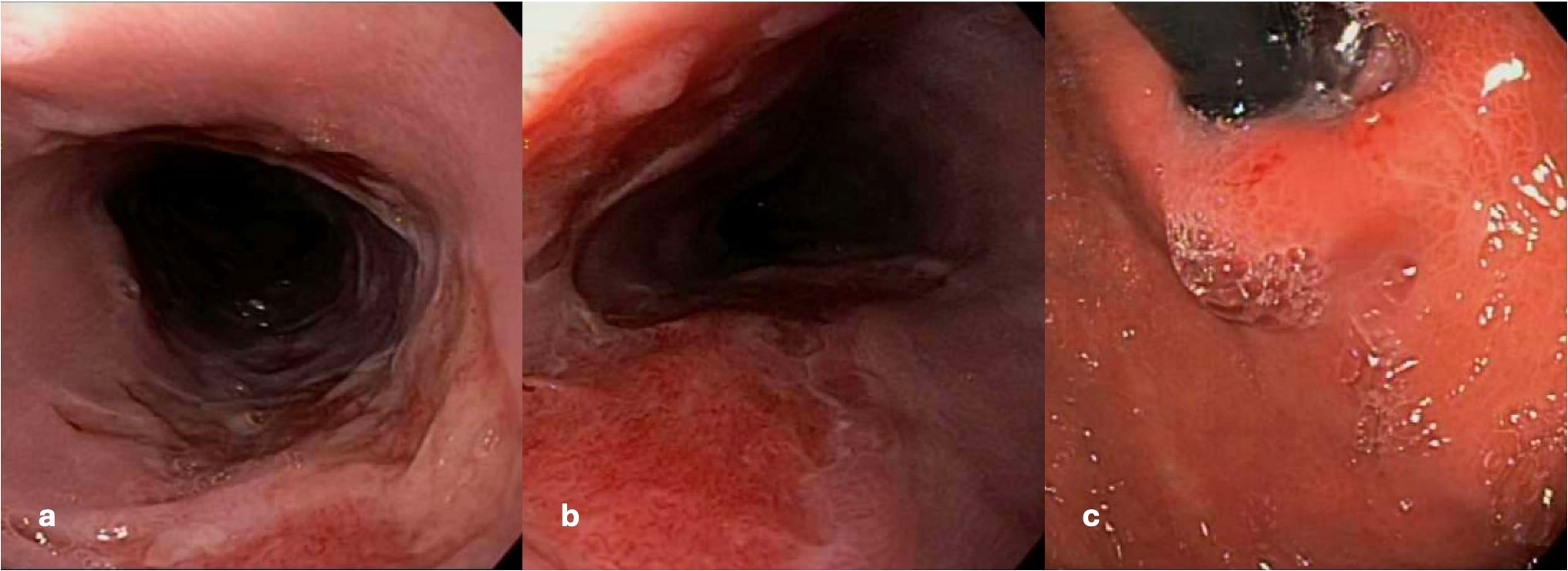Sunday Poster Session
Category: Esophagus
P0738 - Recurrent Cytomegalovirus Esophagitis Complicating New AIDS Diagnosis
Sunday, October 26, 2025
3:30 PM - 7:00 PM PDT
Location: Exhibit Hall

Charles B. Woodall, DO
Louisiana State University Health Sciences Center New Orleans
New Orleans, LA
Presenting Author(s)
Charles Woodall, DO, Nikki Arceneaux, MD
Louisiana State University Health Sciences Center New Orleans, New Orleans, LA
Introduction: Cytomegalovirus (CMV) is the most common opportunistic infection encountered in patients with AIDS with CMV esophagitis being the second most common gastrointestinal manifestation. Treatment typically utilizes ganciclovir with transition to valganciclovir for maintenance therapy. Adherence to antiviral therapy is crucial to prevent relapse of symptoms and progression to disseminated disease but can be complicated by various factors including low health literacy.
Case Description/
Methods: Our patient is a 33-year-old male who initially presented to an outside facility with complaints of chest pain and odynophagia for the previous four to five weeks and sixty pounds of weight loss. He was initially discharged from the outside ED with pantoprazole and metoclopramide only to be called to return four days later after his HIV antibody resulted positive. He was admitted and started on fluconazole out of concern for Candida esophagitis but was given ganciclovir after his CMV PCR came back positive. EGD was performed two days after induction of ganciclovir and revealed several cratered esophageal ulcers with stigmata of recent bleeding. He was transitioned to oral valganciclovir prior to discharge home. Unfortunately, he was not fully adherent with antiviral therapy and presented to our medical center with recurrent CMV esophagitis with concurrent Candida esophagitis as well as CMV retinitis. Ganciclovir and fluconazole were administered as well as intravitreous foscarnet.
Discussion: CMV is one of the most common opportunistic infections in patients with HIV/AIDS, affecting up to 40%, as well as other immunosuppressed patients such as transplant recipients and those receiving chemotherapy. CMV can affect multiple organ systems including the gastrointestinal tract causing colitis, esophagitis, and hepatitis. Esophagitis is the second most frequent gastrointestinal manifestation of CMV infection. Induction therapy normally utilizes ganciclovir for a duration of three to six weeks, but foscarnet is a viable alternative. Valganciclovir can be used if oral intake is tolerated but is more commonly used for maintenance therapy for those with disseminated CMV or recurrent infection such as our patient. Coinfections with Candida are common and seen in up to 73% of patients. Complications include esophageal bleeding and stricture as well as progression to disseminated disease making adherence to antiviral therapy crucial. Unfortunately, low health literacy can make such adherence challenging as seen in our case.

Figure: a. View of middle 1/3 of the esophagus demonstrating diffuse ulceration; b. View of lower 1/3 of the esophagus demonstrating diffuse ulceration and stigmata of recent bleeding; c. Erythematous mucosa of the gastric body due to hyperemia
Disclosures:
Charles Woodall indicated no relevant financial relationships.
Nikki Arceneaux indicated no relevant financial relationships.
Charles Woodall, DO, Nikki Arceneaux, MD. P0738 - Recurrent Cytomegalovirus Esophagitis Complicating New AIDS Diagnosis, ACG 2025 Annual Scientific Meeting Abstracts. Phoenix, AZ: American College of Gastroenterology.
Louisiana State University Health Sciences Center New Orleans, New Orleans, LA
Introduction: Cytomegalovirus (CMV) is the most common opportunistic infection encountered in patients with AIDS with CMV esophagitis being the second most common gastrointestinal manifestation. Treatment typically utilizes ganciclovir with transition to valganciclovir for maintenance therapy. Adherence to antiviral therapy is crucial to prevent relapse of symptoms and progression to disseminated disease but can be complicated by various factors including low health literacy.
Case Description/
Methods: Our patient is a 33-year-old male who initially presented to an outside facility with complaints of chest pain and odynophagia for the previous four to five weeks and sixty pounds of weight loss. He was initially discharged from the outside ED with pantoprazole and metoclopramide only to be called to return four days later after his HIV antibody resulted positive. He was admitted and started on fluconazole out of concern for Candida esophagitis but was given ganciclovir after his CMV PCR came back positive. EGD was performed two days after induction of ganciclovir and revealed several cratered esophageal ulcers with stigmata of recent bleeding. He was transitioned to oral valganciclovir prior to discharge home. Unfortunately, he was not fully adherent with antiviral therapy and presented to our medical center with recurrent CMV esophagitis with concurrent Candida esophagitis as well as CMV retinitis. Ganciclovir and fluconazole were administered as well as intravitreous foscarnet.
Discussion: CMV is one of the most common opportunistic infections in patients with HIV/AIDS, affecting up to 40%, as well as other immunosuppressed patients such as transplant recipients and those receiving chemotherapy. CMV can affect multiple organ systems including the gastrointestinal tract causing colitis, esophagitis, and hepatitis. Esophagitis is the second most frequent gastrointestinal manifestation of CMV infection. Induction therapy normally utilizes ganciclovir for a duration of three to six weeks, but foscarnet is a viable alternative. Valganciclovir can be used if oral intake is tolerated but is more commonly used for maintenance therapy for those with disseminated CMV or recurrent infection such as our patient. Coinfections with Candida are common and seen in up to 73% of patients. Complications include esophageal bleeding and stricture as well as progression to disseminated disease making adherence to antiviral therapy crucial. Unfortunately, low health literacy can make such adherence challenging as seen in our case.

Figure: a. View of middle 1/3 of the esophagus demonstrating diffuse ulceration; b. View of lower 1/3 of the esophagus demonstrating diffuse ulceration and stigmata of recent bleeding; c. Erythematous mucosa of the gastric body due to hyperemia
Disclosures:
Charles Woodall indicated no relevant financial relationships.
Nikki Arceneaux indicated no relevant financial relationships.
Charles Woodall, DO, Nikki Arceneaux, MD. P0738 - Recurrent Cytomegalovirus Esophagitis Complicating New AIDS Diagnosis, ACG 2025 Annual Scientific Meeting Abstracts. Phoenix, AZ: American College of Gastroenterology.
